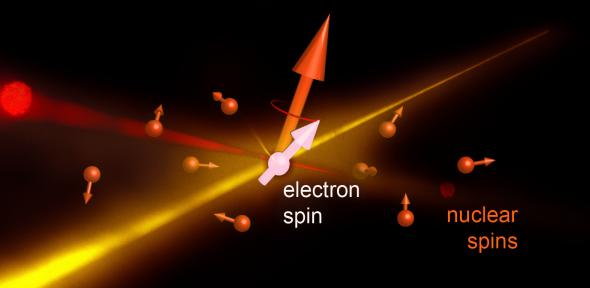10 Oct 2014
Scientists have successfully demonstrated a new way to control the “spin” of an electron – the natural intrinsic angular momentum of electrons which could underpin faster computing in the future. The technique counterintuitively makes use of the ever-changing magnetic field of the electron’s environment - one of the main obstacles to traditional methods of spin control.
A new method of controlling the “spin” of an electron, one of the fastest-developing research topics in quantum-based technologies and widely seen as the potential foundation of numerous future advances, has been demonstrated by scientists.
In quantum physics, the “spin” of a particle refers to its intrinsic angular momentum. This can be controlled so that it is aligned with one of two directions, typically referred to as “up” or “down”.
Usually, researchers define the direction by applying a magnetic field to orientate the electron, called the “quantisation axis”. The process can, however, be distorted by the natural magnetic environment around the electron itself, which is usually seen as one of the biggest obstacles to controlling spin.
Uniquely, the new study, by a team at the University of Cambridge and the Joint Quantum Institute (JQI) in the USA, instead turned this magnetic field into a natural advantage which allowed the electron to be held in place. The researchers did this by firing two precisely-tuned lasers at the particle, creating what they call a “dark state” from which it could be manipulated and measured.
The implications for controlling quantum systems are significant because, since the 1990s, researchers have theorised that a particle’s spin could be used to store and manipulate information. Using the “up” or “down” as an alternative to the binary coding of 0s and 1s that characterises computers today, spin-based quantum computers would be able to compute difficult problems and vast amounts of data much more efficiently.
Any such development, however, depends on finding ways to bring electron spin under control in the first place. To date, researchers have had to find ways to do this in spite of the randomising effect that the magnetic field around an electron has on the orientation of its spin.
The spin of an electron cannot be observed continuously without altering it, so it has to be measured before and after an attempt to manipulate its quantum state. This measurement reveals whether the spin is up or down, but the surrounding magnetic environment can also take effect at any time. If it does so, the quantisation axis of the electron is altered, and the whole picture is distorted. The effect is similar to trying to measure longitude and latitude in a world where the positions of the north and south poles are changing randomly all the time.
Dr Mete Atatüre, a researcher at St John’s College, Cambridge who led part of the new study, said: “In order to perform reliable measurements, we constantly have to fight against this fluctuating magnetic environment. In fact, most research is about trying to keep electrons detached or isolated from it. What is unique about this experiment is that we did the opposite and used this environment as a resource. We created a quantum state that wouldn’t be accessible if the magnetic field wasn’t there.”
The electron was trapped inside a self-assembled “quantum dot”, a tiny structure made from a 10 nanometre-thick indium arsenide droplet, surrounded by gallium arsenide. While both materials are semiconductors, an electron can have a lower energy inside the “quantum dot” than in gallium arsenide. “This forms a natural and stable trap for single electrons within a semiconductor device, providing the desired conditions for defining a spin quantum bit” explained Carsten Schulte, a Cambridge graduate student who worked on the project.
An electron isolated in this fashion can then be targeted with lasers to manipulate its spin. If a laser strikes the quantum dot at certain wavelengths, the electron is optically excited and emits light, or fluoresces, which changes its spin. If, however, the magnetic environment interferes with this the change becomes uncontrollable.
To resolve this, the researchers fired two separate lasers at the quantum dot – one tuned to excite the “up” spin state, the other to excite the “down” state. These interfered with each other destructively, preventing any fluorescence at all and creating a so-called “dark state”.
“You would expect two lasers to raise the level of optical excitation even more, but in fact when this is done no light comes out of the quantum dot,” Jack Hansom, another graduate student in the research team, said. “Optical excitation ceases and the electron finds a unique quantum superposition state, which is neither up nor down.”
By changing the relative phase between the two lasers, they were able to redefine the specific dark state and force the electron into it. This showed that the electron could be manipulated in its own up/down coordinate system without the researchers ever knowing the orientation of up and down during the whole process.
“What is profound is that the electron is always in the same quantum superposition state, but the basis in which it is represented evolves with the nuclear field that remains unknown to us,” Atatüre added. “This research shows that the magnetic environment around the quantum dot does not need to remain a problem, but can be utilized for the definition and control of a quantum bit.”
The full report appears in the October issue of Nature Physics.
This work is licensed under an attribution, noncommercial, share-alike Creative Commons Licence. The original article can be read at
www.cam.ac.uk/research
http://www.cam.ac.uk/research/news/spin-with-a-new-twist













